Evaluating trade-offs, and identifying safe operating space for management decisions
Balancing ecosystem constraints and user needs and values necessarily requires managers of coupled social-ecological systems to evaluate trade-offs among stakeholders. In fisheries, operationalizing ecosystem-based management requires that we confront allocation issues not only among fisheries sectors, but also to the ecosystem. Using a tipping points lens helps managers identify the safe operating space for decisions based on ecosystem targets and people’s preferences and risk tolerances.
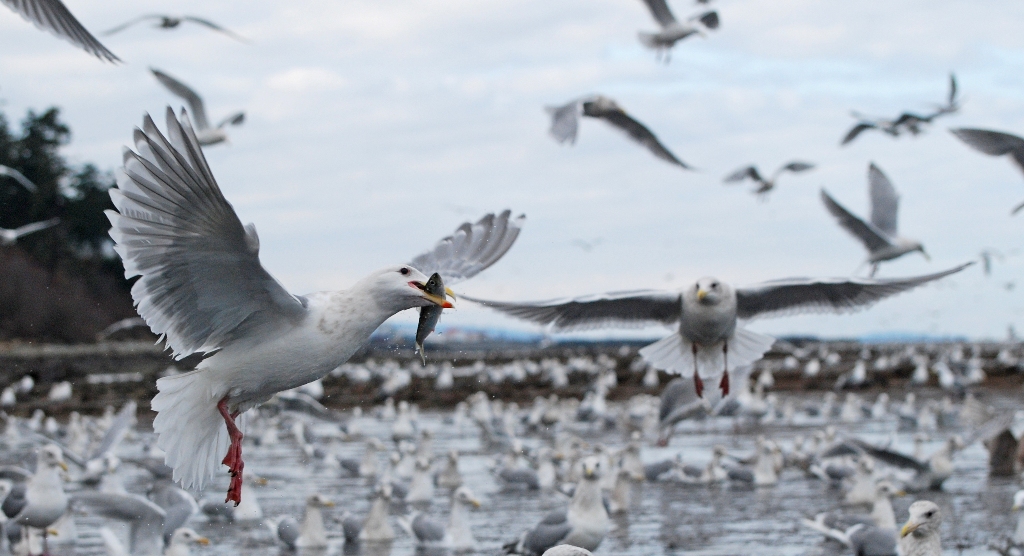
Pacific herring are emblematic of the need to evaluate trade-offs among alternative forms of exploitation and conservation goals. In Haida Gwaii, Pacific herring are subject to at least two distinct fisheries: one that catches mature spawning adults for their eggs and another that harvests the eggs on kelp substrate after spawning occurs. In addition, natural environmental variation influences herring recruitment. Thus, assessing trade-offs should include evaluation of how this recruitment uncertainty can influence risk of fishery closures. Finally, managers of forage fish fisheries also are faced with accounting for ecosystem needs when determining appropriate harvest rates. To address these trade-offs, our team developed a stochastic, age-structured model to investigate the consequences of egg- and adult-harvest on herring populations, fisheries, and conservation of herring predators (e.g., seabirds) (Shelton et al., 2014). We examine how different combinations of harvest intensity affect herring biomass in relation to species-specific biomass thresholds and ecosystem thresholds in the form of herring biomass needed to support predators. Our approach provides a template to evaluate trade-offs between the two fisheries in terms of catch of adults and eggs, and includes risk to fisheries in terms of probability of fishery closures and the risk to ecosystems based on the dietary needs of predators that rely on herring stocks. We use the 1/3 for the birds rule of thumb to set a minimum threshold biomass to be left in the ecosystem for predators. The model also incorporates environmental variation in climate drivers and variable population dynamics to understand a range of potential changes to herring populations that could occur with different harvest strategies.
We find that (a) there is a strong and asymmetric trade-off between the catch of adults and catch of eggs, where small changes in adult harvest can lead to large declines in mean egg catch but the effect of egg harvest on adult catch is relatively minor; (b) risk of fishery closure can change substantially under different recruitment scenarios where populations with high recruitment variability will decline below species-level biomass thresholds more frequently than populations with small recruitment variability; (c) many combinations of egg and adult-harvest rates can allow the herring fishery to remain open while at the same time maintaining average herring biomass above the ecosystem threshold intended to satisfy the needs of herring predators (Figure 6, Shelton et al. 2014).
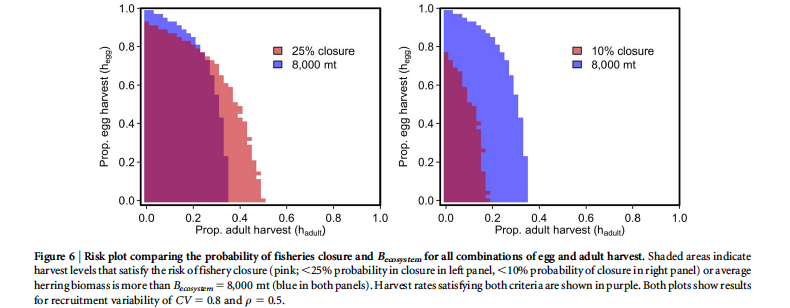
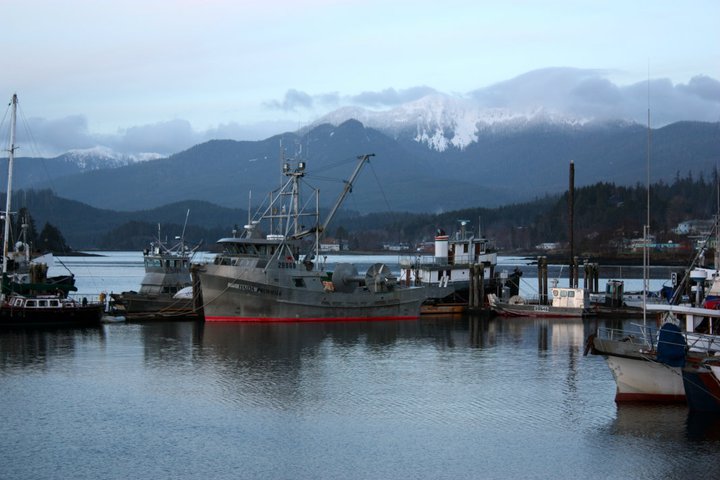 One of the most striking aspects of our model predictions is that ecosystem thresholds proposed to ensure the persistence of herring predators do not necessarily pose more stringent constraints on fisheries than these fisheries pose on themselves via hypothetical, but realistic, management targets. Interestingly, a hypothetical management target that avoids fishery closures more than 10% of the time placed a stronger constraint on both adult and egg harvest rates than the ecosystem threshold. Thus, an important lesson from these analyses is that the safe operating space for fishermen and conservationists can be similar and can aid in facilitating management actions to ensure fisheries and ecosystem needs are met in the long-term. Our work highlights that safe operating spaces exist that will allow the maintenance of stock biomass at levels that facilitate the persistence of forage fish predators and forage fish fisheries.
One of the most striking aspects of our model predictions is that ecosystem thresholds proposed to ensure the persistence of herring predators do not necessarily pose more stringent constraints on fisheries than these fisheries pose on themselves via hypothetical, but realistic, management targets. Interestingly, a hypothetical management target that avoids fishery closures more than 10% of the time placed a stronger constraint on both adult and egg harvest rates than the ecosystem threshold. Thus, an important lesson from these analyses is that the safe operating space for fishermen and conservationists can be similar and can aid in facilitating management actions to ensure fisheries and ecosystem needs are met in the long-term. Our work highlights that safe operating spaces exist that will allow the maintenance of stock biomass at levels that facilitate the persistence of forage fish predators and forage fish fisheries.
Another novel aspect of this study is that we demonstrate a framework for integrating metrics that are socio-culturally relevant with ecological and economic metrics. By focusing on fisheries closures, we evaluate potential management actions based on something that really matters to people and for which different groups (e.g., subsistence users vs. commercial fishermen) may have different thresholds and risk tolerance.
Many decision contexts contend with trade-offs that are non-linear, and these types of analyses can provide a transparent and straightforward decision support tool to address such non-linearities. This model and its scenarios can highlight opportunities for collaboration and cooperation among different stakeholders and offers the chance to avoid unintended consequences on unfished life stages and species. To facilitate this collaboration, we have developed an interface based on the model that can be used in a participatory process with stakeholders to help identify stakeholders’ risk tolerances and preferences for different fisheries management decisions.
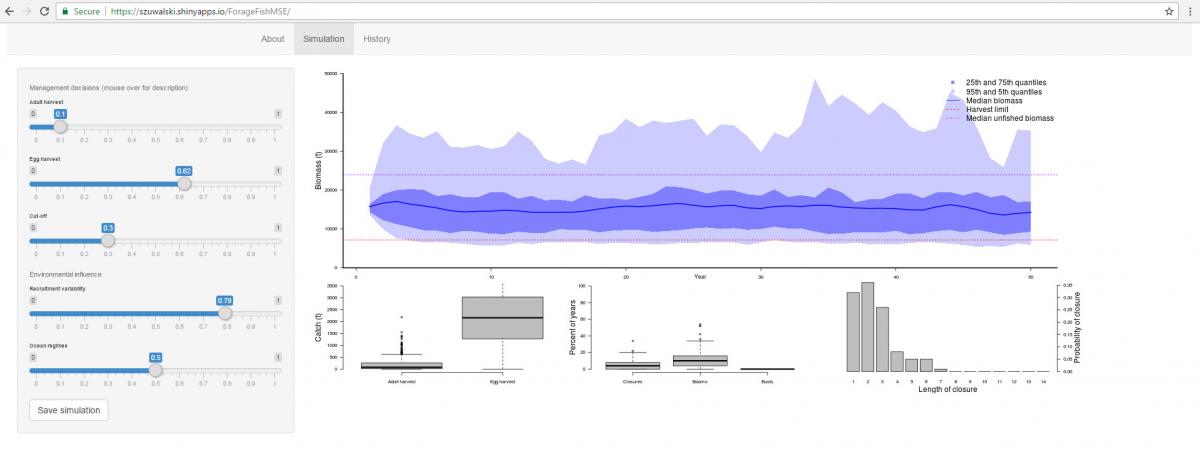
This decision tool allows stakeholders to explore the models we developed and change environmental parameters, biomass thresholds, and harvest rates to evaluate risk of fisheries closures and catch rates for herring adults and eggs. This will allow for information exchange and help decision makers and stakeholders work together to strike a balance between the competing needs of multiple stakeholders and species in the face of tipping points.
To find out more, see our research paper, and check out our Decision Tool.
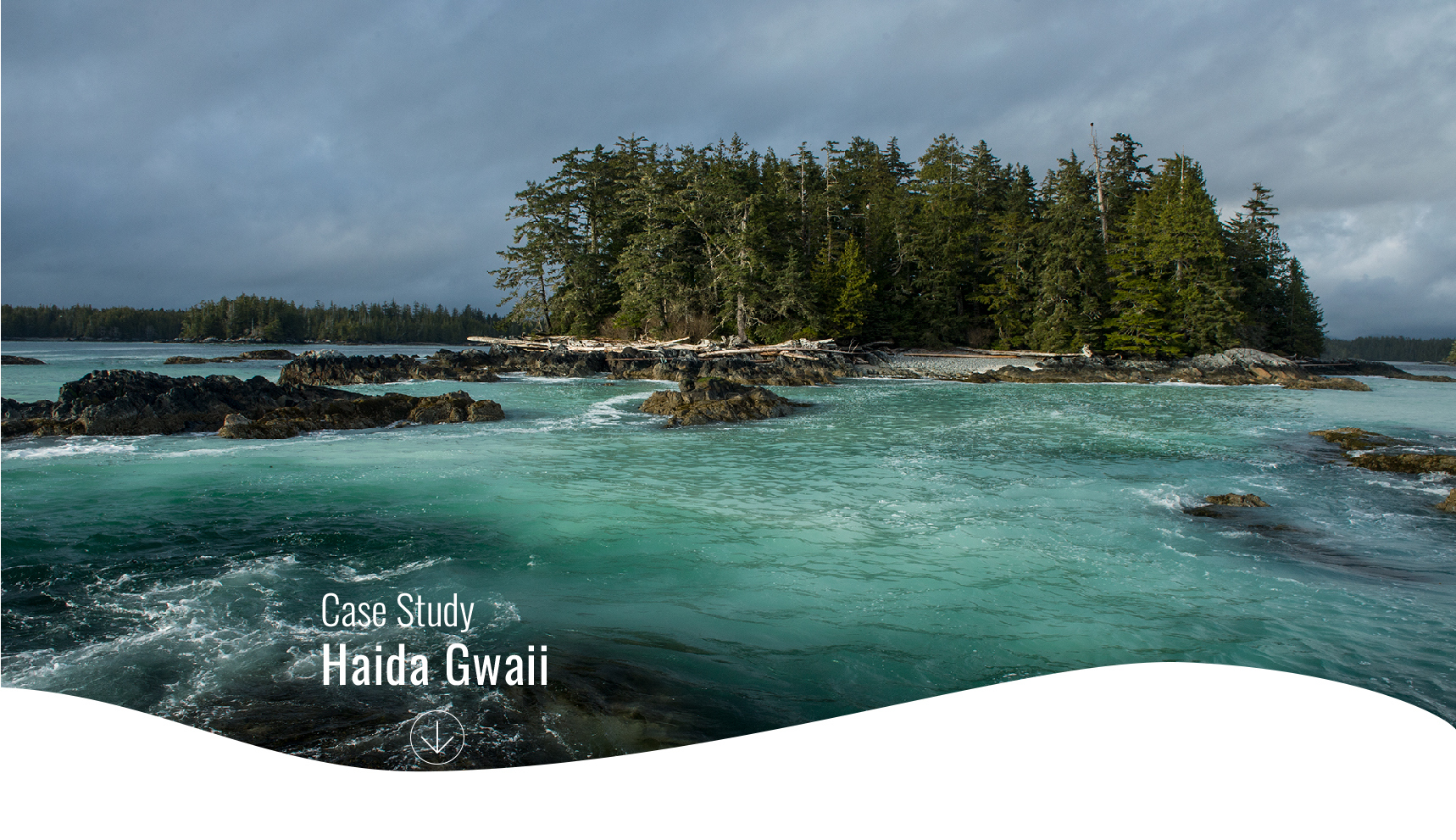
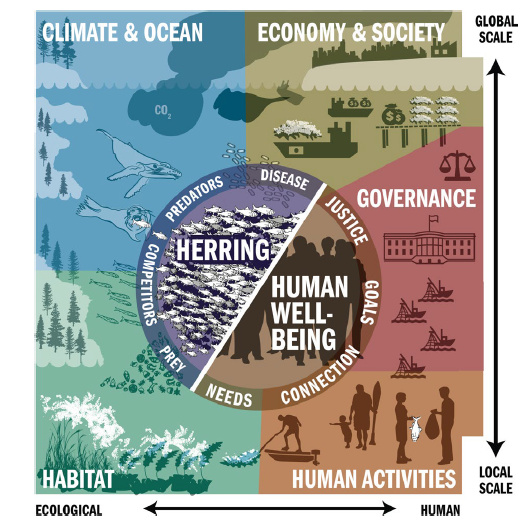 Globally, many fisheries have crossed critical thresholds (i.e., tipping points) with serious ecological, economic, and cultural consequences
Globally, many fisheries have crossed critical thresholds (i.e., tipping points) with serious ecological, economic, and cultural consequences Across the northwest coast of North America, Pacific herring and its eggs or roe are critical prey for a host of fish (e.g., hake, Pacific cod, dogfish, salmon, rockfish), birds (e.g., puffins, gulls), and marine mammal predators (e.g., humpback whales, stellar sea lions, seals), as well as some terrestrial predators (e.g., black bears). Declines in herring, like other forage fish, are thought to affect the recovery of these predators, some of which are threatened or endangered species. Recent work, for example, has quantified the link between the biomass of forage fish in the ecosystem and seabird breeding success. Tipping points science identifies an ecosystem threshold of 1/3 for the birds, suggesting that forage fish biomass should be maintained at levels higher than typical fisheries harvest guidelines allow
Across the northwest coast of North America, Pacific herring and its eggs or roe are critical prey for a host of fish (e.g., hake, Pacific cod, dogfish, salmon, rockfish), birds (e.g., puffins, gulls), and marine mammal predators (e.g., humpback whales, stellar sea lions, seals), as well as some terrestrial predators (e.g., black bears). Declines in herring, like other forage fish, are thought to affect the recovery of these predators, some of which are threatened or endangered species. Recent work, for example, has quantified the link between the biomass of forage fish in the ecosystem and seabird breeding success. Tipping points science identifies an ecosystem threshold of 1/3 for the birds, suggesting that forage fish biomass should be maintained at levels higher than typical fisheries harvest guidelines allow

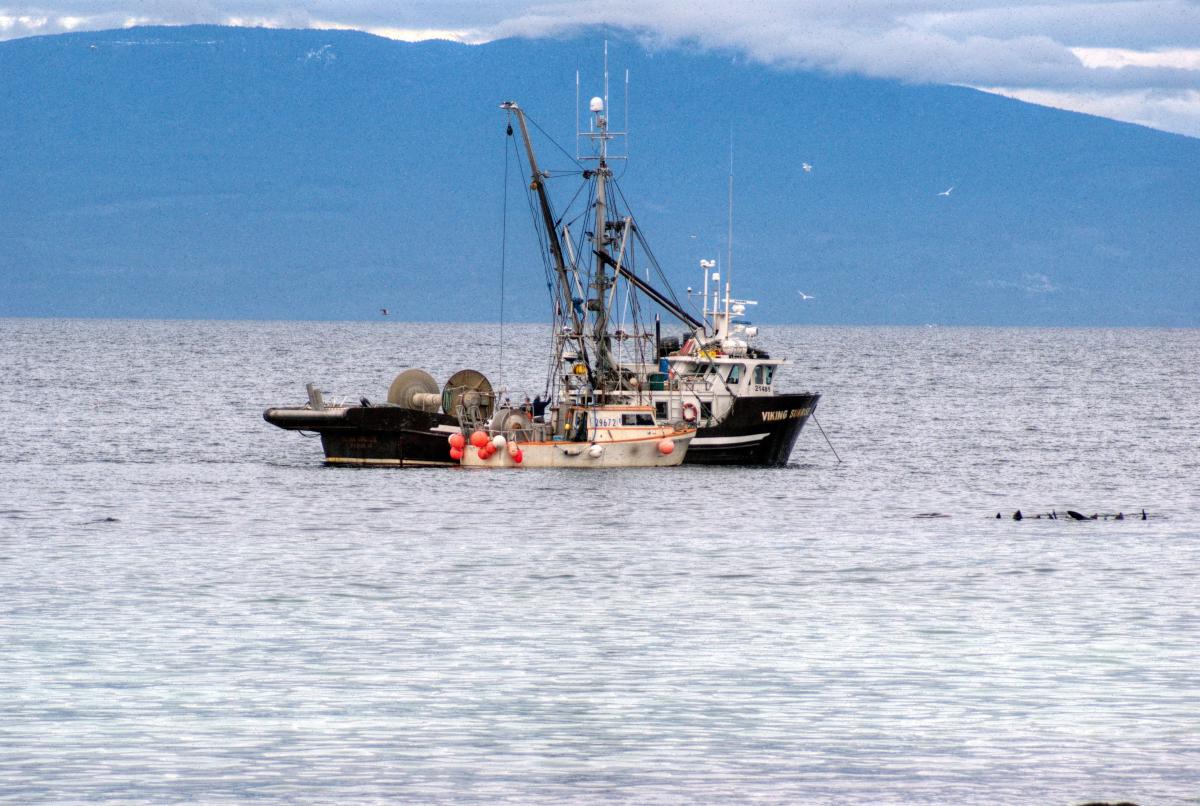 In Haida Gwaii, we analyzed time series of herring spawn and herring catch data at both regional and local scales and examined two potential drivers of change: commercial fishing, and ocean climate (Stier et al in prep). Our results indicate that recent slow recovery of the overall Haida Gwaii herring population is due to depressed population growth rates in 90% of stocklets. We also found that fishing and ocean conditions were key regional environmental drivers impacting herring dynamics. Regional ocean temperature affected herring population growth, with herring population growth rates increasing in cold years and decreasing in warm years, particularly for stocklets with low intrinsic growth rates. Strong differences in the timing and location of fishing further contributed to declines in overall herring populations across the archipelago. However, our model indicates that there are other drivers of this ecosystem shift for which we haven’t accounted. One driver in particular that we didn’t examine was the recovery of marine mammals that prey on herring. Increases in humpback whales and sea lions may underlie declines in herring population growth.
In Haida Gwaii, we analyzed time series of herring spawn and herring catch data at both regional and local scales and examined two potential drivers of change: commercial fishing, and ocean climate (Stier et al in prep). Our results indicate that recent slow recovery of the overall Haida Gwaii herring population is due to depressed population growth rates in 90% of stocklets. We also found that fishing and ocean conditions were key regional environmental drivers impacting herring dynamics. Regional ocean temperature affected herring population growth, with herring population growth rates increasing in cold years and decreasing in warm years, particularly for stocklets with low intrinsic growth rates. Strong differences in the timing and location of fishing further contributed to declines in overall herring populations across the archipelago. However, our model indicates that there are other drivers of this ecosystem shift for which we haven’t accounted. One driver in particular that we didn’t examine was the recovery of marine mammals that prey on herring. Increases in humpback whales and sea lions may underlie declines in herring population growth. 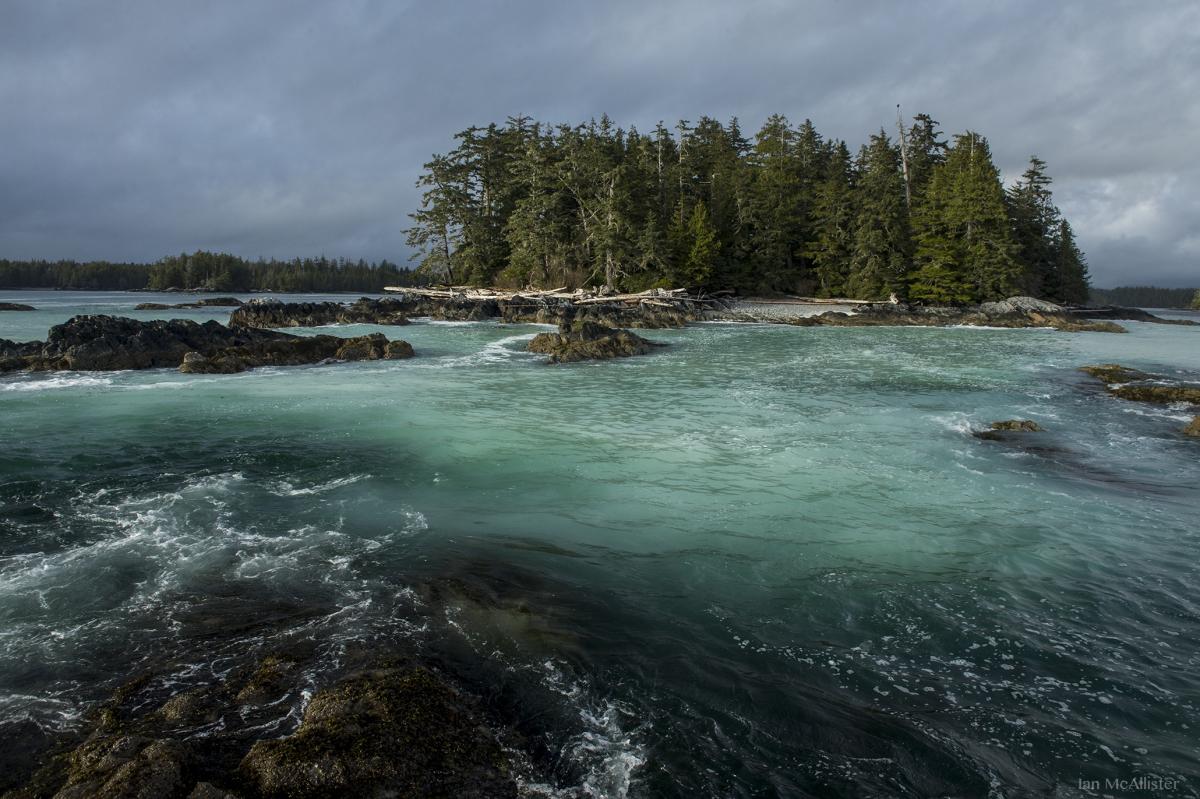
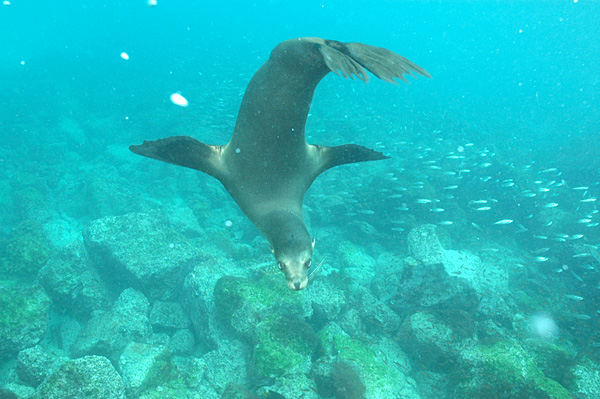 Although we didn’t examine the recovery of predator populations as a driver in our spatial model, understanding these species interactions is a key element for understanding drivers of change and ecosystem shifts. This is because species can be influenced by changes to their predators, prey, or competitors, and are embedded in complex food webs with many interactions. Herring and other forage fish are key species in nearshore pelagic food webs, whose abundance can be influenced by their predators, such as humpback whales, and their food sources, primarily zooplankton. Changes in herring can also influence other species in the food web, leading to overall ecosystem shifts.
Although we didn’t examine the recovery of predator populations as a driver in our spatial model, understanding these species interactions is a key element for understanding drivers of change and ecosystem shifts. This is because species can be influenced by changes to their predators, prey, or competitors, and are embedded in complex food webs with many interactions. Herring and other forage fish are key species in nearshore pelagic food webs, whose abundance can be influenced by their predators, such as humpback whales, and their food sources, primarily zooplankton. Changes in herring can also influence other species in the food web, leading to overall ecosystem shifts.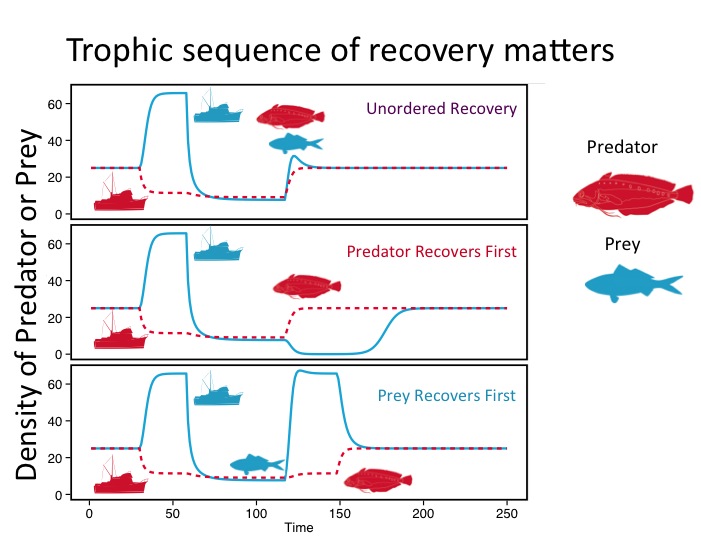
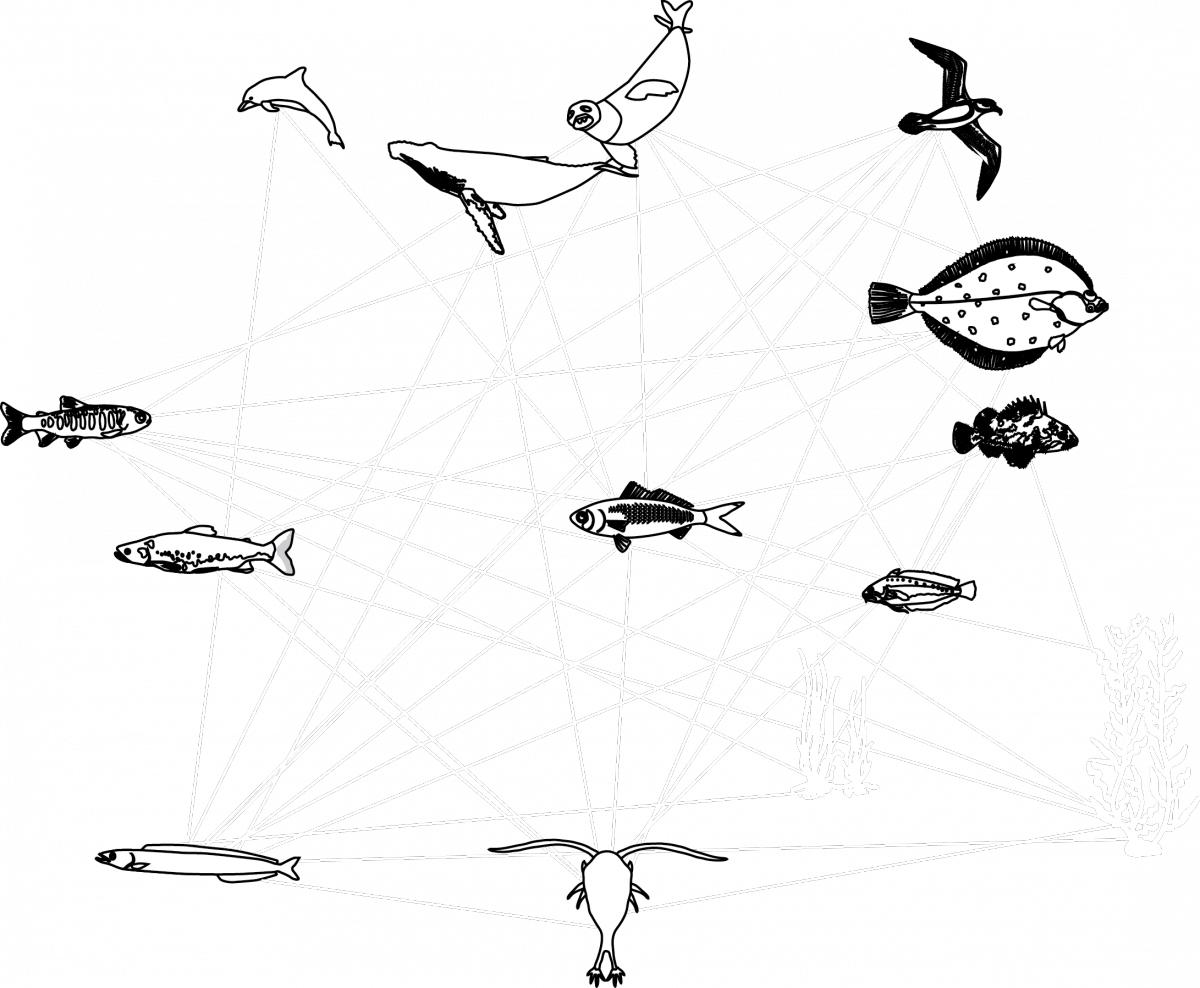
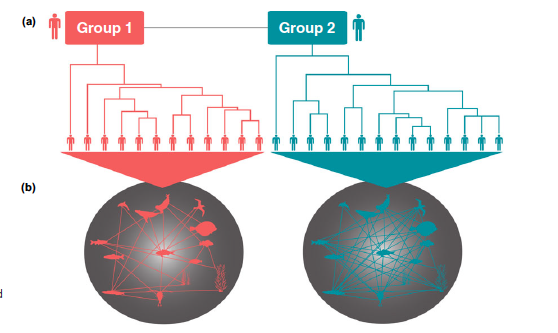
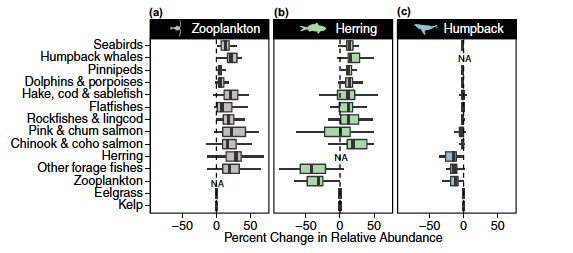
 Pacific herring are key species that contribute to cultural, social and economic well-being in Haida Gwaii. Herring have been central to Haida lives, livelihoods and culture for thousands of years (Jones 2000, Jones 2005, MacKechnie et al. 2013; Haida Marine Traditional Knowledge Study 2011). To understand the diverse socio-cultural values and practices regarding herring, we worked with the Haida Nation to implement semi-structured interviews with Haida community members. This helped us characterize the social impacts of ecological and management changes, both past and future, and is helping guide goal-setting for fisheries and ecosystem managers in Haida Gwaii. Linking Haida values for and relationships with herring with the spatio-temporal changes in herring populations, we identified potential social-ecological tipping points in the system. Specifically, we identified thresholds of herring abundance and distribution that exist for meeting cultural objectives. Such cultural objectives include, for example, resource access, knowledge sharing, identity, and cultural continuity. When there is enough herring and roe on kelp to harvest in the right places at the right time, community members can take part in harvesting and share knowledge across generations about where and how to harvest, and maintain these cultural values. Herring roe on kelp is an important food in the seasonal round and contributes to community well-being, health and food sharing. In addition to these harvest values, herring are important to Haida as a way to connect with the ocean and other animals linked to herring.
Pacific herring are key species that contribute to cultural, social and economic well-being in Haida Gwaii. Herring have been central to Haida lives, livelihoods and culture for thousands of years (Jones 2000, Jones 2005, MacKechnie et al. 2013; Haida Marine Traditional Knowledge Study 2011). To understand the diverse socio-cultural values and practices regarding herring, we worked with the Haida Nation to implement semi-structured interviews with Haida community members. This helped us characterize the social impacts of ecological and management changes, both past and future, and is helping guide goal-setting for fisheries and ecosystem managers in Haida Gwaii. Linking Haida values for and relationships with herring with the spatio-temporal changes in herring populations, we identified potential social-ecological tipping points in the system. Specifically, we identified thresholds of herring abundance and distribution that exist for meeting cultural objectives. Such cultural objectives include, for example, resource access, knowledge sharing, identity, and cultural continuity. When there is enough herring and roe on kelp to harvest in the right places at the right time, community members can take part in harvesting and share knowledge across generations about where and how to harvest, and maintain these cultural values. Herring roe on kelp is an important food in the seasonal round and contributes to community well-being, health and food sharing. In addition to these harvest values, herring are important to Haida as a way to connect with the ocean and other animals linked to herring. 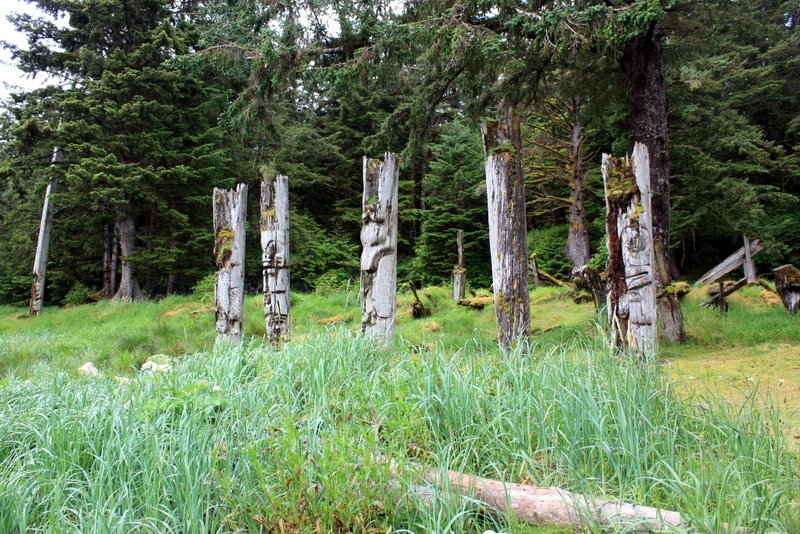 A guiding principle of the Gwaii Haanas Interim Management Plan (GHIMP 2010) is to “balance protection and ecologically sustainable use,” a goal that extends to all of the land a seascapes of the Haida Gwaii archipelago. Furthermore, the GHIMP stipulates that management actions in Haida Gwaii must respect a range of environmental, social, economic and cultural values. However, there remains some ambiguity with respect to how ecological goals for sustainability intersect with social, cultural, and economic goals. To resolve this, we are helping to build a definition of sustainability for herring fisheries that embeds the socio-cultural values regarding herring on Haida Gwaii. To do this, we used mixed community-based social science research methods. Starting with categories of sustainability and the herring fishery that we are generating from existing documents, we implemented semi-structured interviews with local people to identify how they further define sustainability with respect to their relationships with herring and the marine environment. We then held a set of workshops that implement “Q-methodology”, where residents of Haida Gwaii are asked to sort a series of statements about sustainability and the marine environment developed from our interviews. This provided an understanding of the factors that influence perceptions of sustainability in the herring fishery and ecosystem management. These statements will be further integrated into
A guiding principle of the Gwaii Haanas Interim Management Plan (GHIMP 2010) is to “balance protection and ecologically sustainable use,” a goal that extends to all of the land a seascapes of the Haida Gwaii archipelago. Furthermore, the GHIMP stipulates that management actions in Haida Gwaii must respect a range of environmental, social, economic and cultural values. However, there remains some ambiguity with respect to how ecological goals for sustainability intersect with social, cultural, and economic goals. To resolve this, we are helping to build a definition of sustainability for herring fisheries that embeds the socio-cultural values regarding herring on Haida Gwaii. To do this, we used mixed community-based social science research methods. Starting with categories of sustainability and the herring fishery that we are generating from existing documents, we implemented semi-structured interviews with local people to identify how they further define sustainability with respect to their relationships with herring and the marine environment. We then held a set of workshops that implement “Q-methodology”, where residents of Haida Gwaii are asked to sort a series of statements about sustainability and the marine environment developed from our interviews. This provided an understanding of the factors that influence perceptions of sustainability in the herring fishery and ecosystem management. These statements will be further integrated into 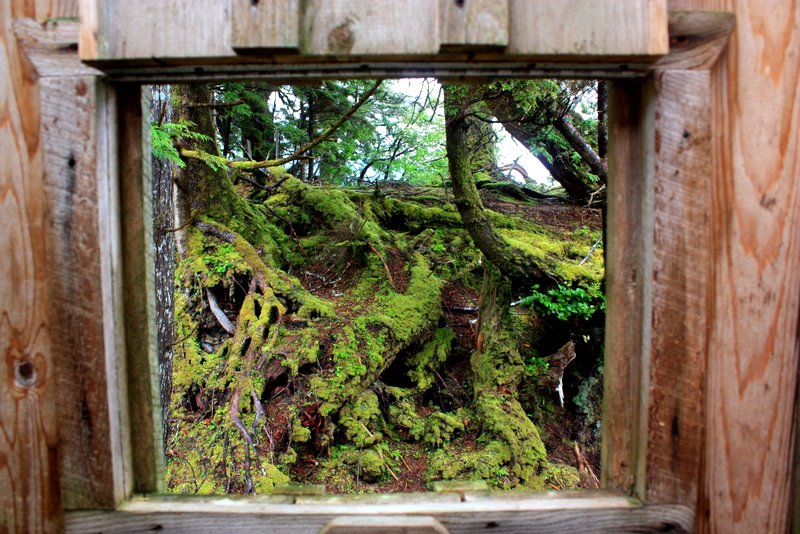 Residents of Haida Gwaii, both Haida and non-Indigenous, offered to us several ways that the sustainability of their households and communities is linked to the status of the marine environment. Fisheries, such as salmon and herring, are among the most commonly identified ways that local people depend on marine ecosystems, but people also noted numerous additional amenities that relate more broadly to their quality of life. That is, the natural spaces of the Haida Gwaii archipelago do more than simply provide food for local residents. Local people shared with us a deep psychological connection to the place; parents describe the benefits of bringing up their children there, and islands’ youth talk about the archipelago as a place of possibility. Many non-Indigenous families, for example, talk about how both the abundant natural resources, marine as well as terrestrial, and also the overall quality of life provided by the rich local environment, offsets for them the challenges of remoteness posed by living on the Archipelago.
Residents of Haida Gwaii, both Haida and non-Indigenous, offered to us several ways that the sustainability of their households and communities is linked to the status of the marine environment. Fisheries, such as salmon and herring, are among the most commonly identified ways that local people depend on marine ecosystems, but people also noted numerous additional amenities that relate more broadly to their quality of life. That is, the natural spaces of the Haida Gwaii archipelago do more than simply provide food for local residents. Local people shared with us a deep psychological connection to the place; parents describe the benefits of bringing up their children there, and islands’ youth talk about the archipelago as a place of possibility. Many non-Indigenous families, for example, talk about how both the abundant natural resources, marine as well as terrestrial, and also the overall quality of life provided by the rich local environment, offsets for them the challenges of remoteness posed by living on the Archipelago. 

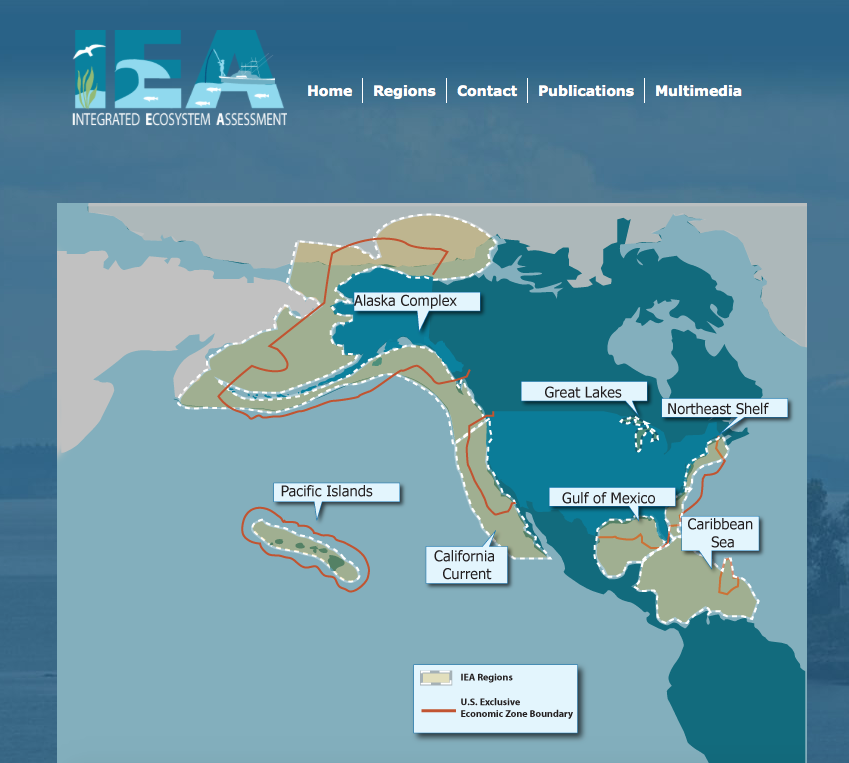 Given limited resources, the goal is to identify a set of indicators that can provide adequate information on status and trends and determine whether reference points or targets have been met and management goals achieved. In the face of tipping points, managers may want to include a number of early warning indicators in their portfolio. In Haida Gwaii, Pacific herring are key components in a broader ecosystem. To manage ecosystems in Gwaii Haanas National Marine Conservation Area and Haida Heritage Site, managers needed to identify key components and determine indicators to include in their management and monitoring plans. To help inform their selection of a portfolio of indicators, the Ocean Tipping Points team identified a suite of potential indicators using a framework from NOAAs Integrated Ecosystem Assessment developed for the California Large Marine Ecosystem.
Given limited resources, the goal is to identify a set of indicators that can provide adequate information on status and trends and determine whether reference points or targets have been met and management goals achieved. In the face of tipping points, managers may want to include a number of early warning indicators in their portfolio. In Haida Gwaii, Pacific herring are key components in a broader ecosystem. To manage ecosystems in Gwaii Haanas National Marine Conservation Area and Haida Heritage Site, managers needed to identify key components and determine indicators to include in their management and monitoring plans. To help inform their selection of a portfolio of indicators, the Ocean Tipping Points team identified a suite of potential indicators using a framework from NOAAs Integrated Ecosystem Assessment developed for the California Large Marine Ecosystem. 